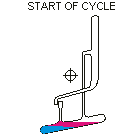SOLVENT EXTRACTION
Solvent extraction, also called liquid-liquid extraction
Immiscible liquids are ones that cannot get mixed up together and separate into layers when shaken together. These liquids are usually water and an organic solvent. •
Solvent extraction is the process in which a compound transfers from one solvent to another owing to the difference in solubility or distribution coefficient between these two immiscible (or slightly soluble) solvents. • It is a method of quantitative separation of compounds. • When extracting solvent is stirred with solution containing solute then solute from original solvent gets transferred into an extracting solvent. • When stirring is stopped extracting solvent form separate layer and now it contains solute of interest. • Compared with other separation methods, it gives a better separation effect than chemical precipitation, and a higher degree of selectivity and faster mass transfer than the ion exchange method. • Compared with distillation, solvent extraction has advantages such as low energy consumption, large production capacity, fast action, easy continuous operation and ease of automation.
Commonly used solvents • ethyl acetate (8.1 %), • diethyl ether (6.9 %), • dichloromethane (1.3 %) and • chloroform (0.8 %) dissolved up to 10 % in water. Water also dissolves in organic solvents: • ethyl acetate (3 %), • diethyl ether (1.4 %), • dichloromethane (0.25 %) • chloroform (0.056 %).
Uses of solvent extraction process • Solvent extraction is used in the processing of perfumes, vegetable oil, or biodiesel. • It is also used to recover plutonium from irradiated nuclear fuel, a process which is usually called nuclear reprocessing. • The recovered plutonium can then be re-used as nuclear fuel.
The properties of the solvent used for solvent extraction
1. The solvent should be well miscible with the liquid to be extracted. 2. The solvent should not be miscible with the other components of the mixture or react with the solute. 3. The boiling point of the solvent should be low enough ( well below the melting point of the solute) such that it can be evaporated easily after collection. 4. It should have a favourable temperature coefficient.
Distribution coefficient •
When a solution is placed in a separatory funnel and shaken with an immiscible solvent, solutes often dissolve in part into both layers. • The components are said to "partition" between the two layers, or "distribute themselves" between the two layers. • When equilibrium has established, the ratio of concentration of solute in each layer is constant for each system, and this can be represented by a value K • K is called the partition coefficient or distribution coefficient.
• When a compound is placed in contact with two immiscible liquids then the compound itself get distributed in these two liquids. • This is an equilibrium process (dissolution equilibrium) governed by temperature of the system. • Suppose compound A is to be extracted from aqueous solution into organic liquid, then for compound A
• Under dissolution equilibrium concentration of compound A in aqueous phase and in organic phase is definite. •
KD=Concentration in organic phase / Concentration in aqueous phase
Factors affecting solvent extraction •
pH – pH affects stability and charge on the metal complex. The pH at which metal ion complex is most stable and neutral is the best pH for extraction of metal ions. •
Salting effect – the high concentration of salt sometimes help to extract metal ions from aqueous phase to organic phase. Salt increases ionic strength of aqueous phase and thereby increases the solubility of metal complex into organic phase. •
Synergic agents – these are reagents which when added to organic phase increase the efficiency of extraction. They get associated with metal complex, make it more soluble into organic phase.
Applications of solvent extraction
Determination of iron
• Determination of lead in the blood
• Determination of copper in the alloys such as steel
• Determination of uranium
• Separation and Purification of organic compounds by organic chemists
• Used in drug industry by analytical chemists, bio-chemists, pharma chemists.

Comments
Post a Comment